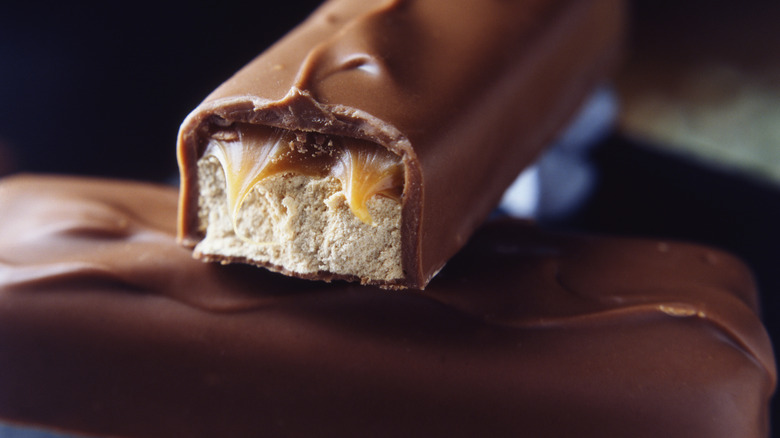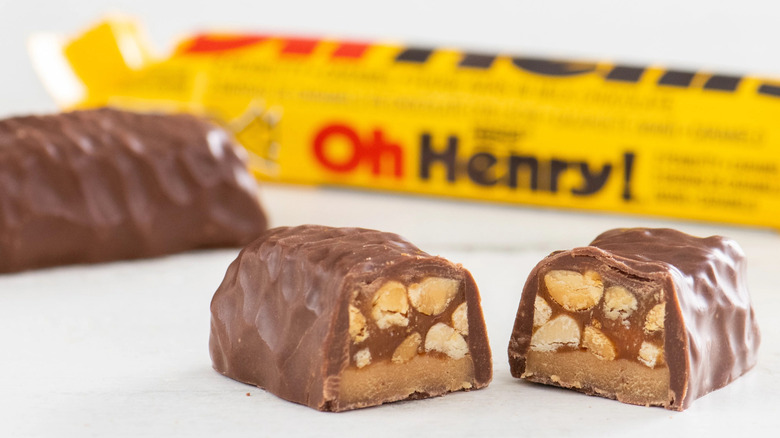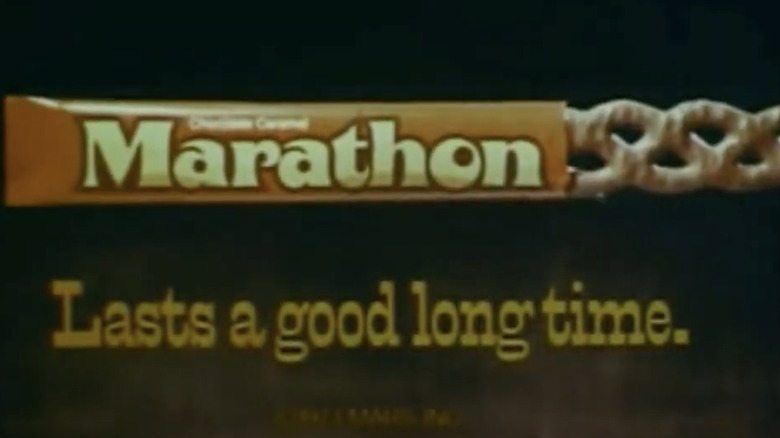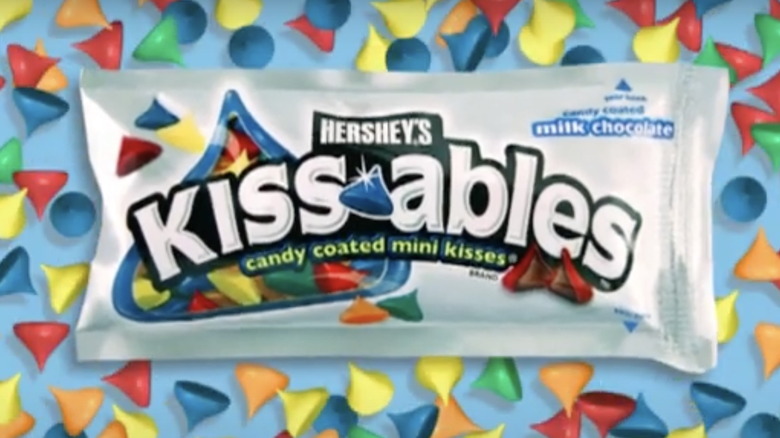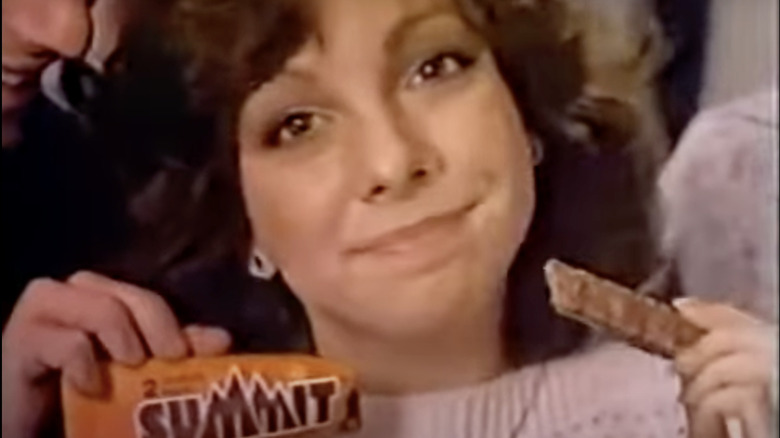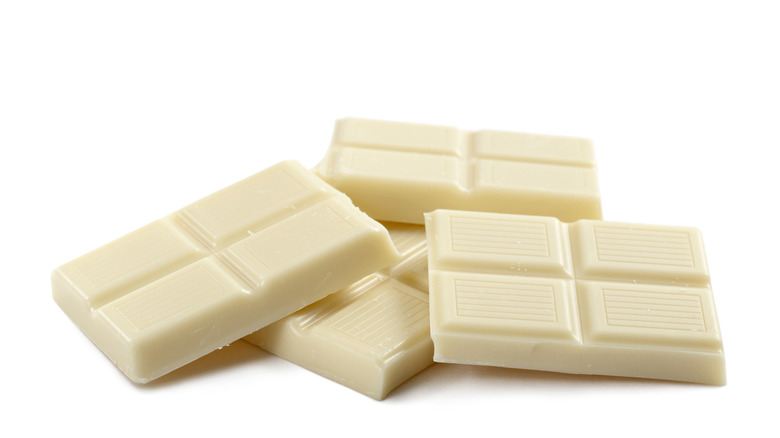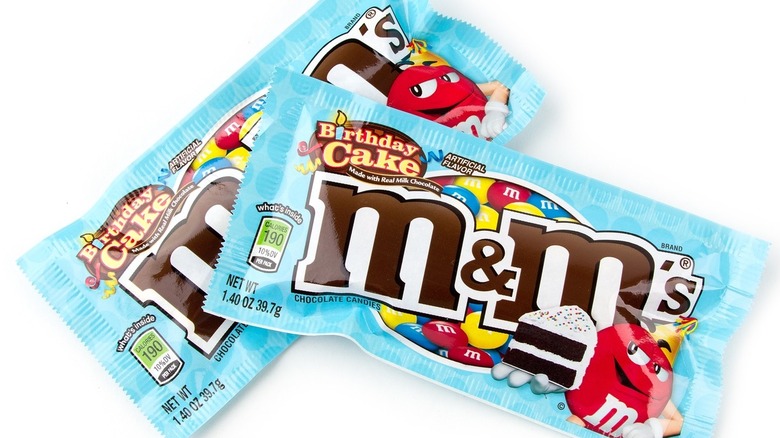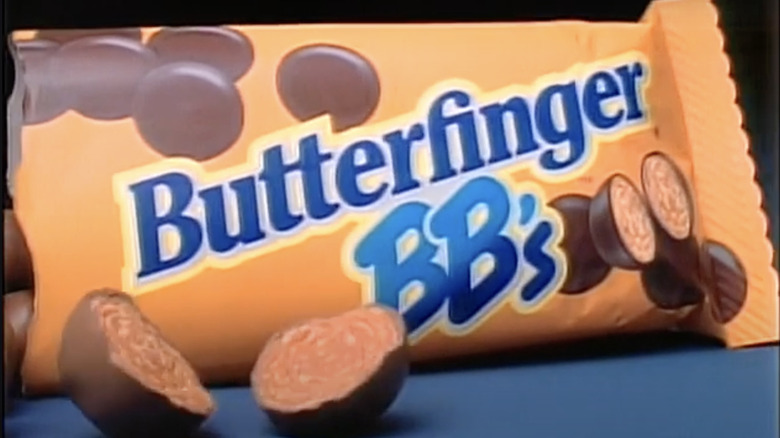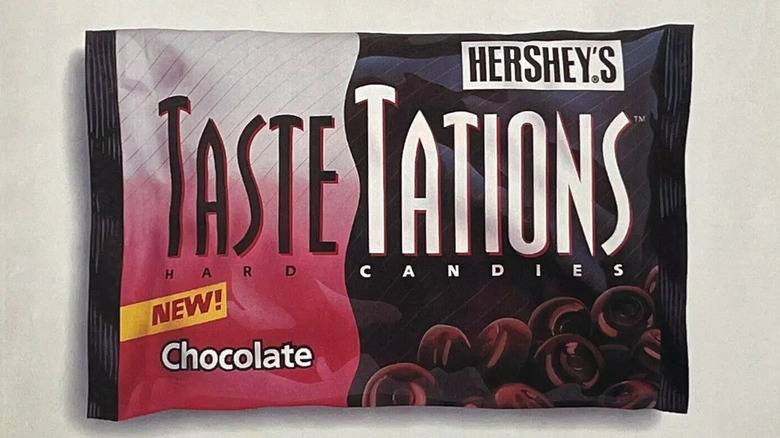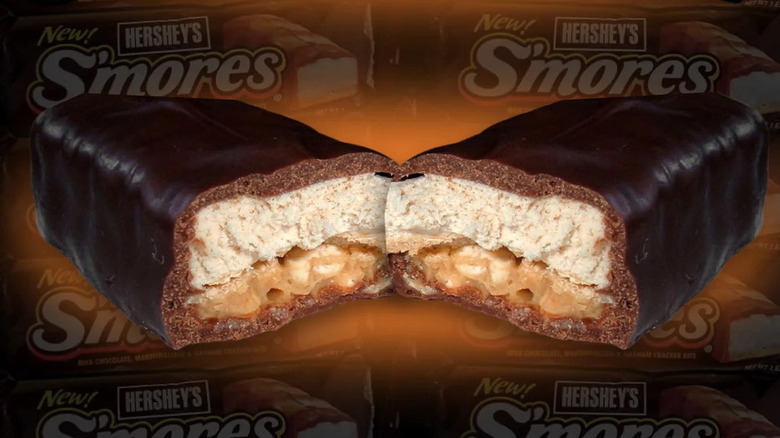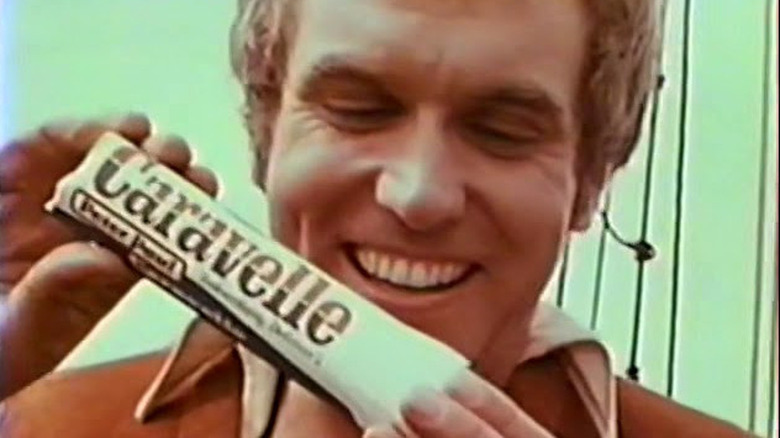Discontinued Chocolate Candy We'll Probably Never Eat Again
When it comes to chocolate candy, youth is definitely not wasted on the young. As kids, we fully relished every chocolate bar, bite, and (hollow) bunny we could get our mouths on. The magic was so real, we can still recall the sensory details of our favorites. These candies came with brilliantly designed wrappers, catchy TV jingles, and newfangled flavors and textures that brought comfort and near euphoria. Compared to the more homogenous chocolates of today, throwback candies had way better stories to tell.
"Candy makes people remember," said vintage treat vendor Kenny Searles of The Candy Factory in Lexington, North Carolina, in an interview with Our State. "It's like a song. Like something you haven't thought of in forever, and then it comes on the radio, and you're right back there again." Many years may pass, but our strong, candy-coated emotions remain close and forever enticing. It makes wonderful sense. Sweet treats are intricately woven into our milestone memories of happy times, simpler times: summer camp, little league, first dates, and grandma's crystal candy dish [sigh].
While all kinds of chocolate candies come and go, it's especially hard to swallow the discontinuation of your childhood favorites. Some people take to starting fan pages or pleading petitions, while others search endlessly for acceptable replacements. When you end up empty-handed, a feel-good walk down memory lane might be the closest you can get to the real thing. Hailing from the 1920s to 2020s, here are 12 remarkable chocolate candies we may never eat again.
Oh Henry!
Memorable TV commercials from the late 1980s featured comedian Gilbert Gottfried asking in his legendary shrill voice: "What makes the Oh Henry! Bar so intense?" He takes a bite, but can't decide it's the peanuts, the milk chocolate, the caramel, or the touch of fudge.
While plenty of candy companies have capitalized on this combo over the years, back in 1920, Oh Henry! (made by Chicago's Williamson Candy Company) was one of the first. It hit the market a year before Curtiss Candy Co.'s Baby Ruth, and a full decade before Snickers. In its heyday, Oh Henry! inspired newfound cravings and quite a bit of intrigue. The bar was so novel — and comparatively decadent — that high society women sliced and served the candy for teas, bridge games, Mah-jongg, and fancy dinner parties. Williamson even created a recipe book, "60 New Ways to Serve a Famous Candy," highlighting how Oh Henry! could be used in cakes, puddings, and other elegant desserts.
So who, exactly, was the Henry in Oh Henry? Chocolate lovers have always taken pleasure in the folklore surrounding the candy bar's mysterious name. But, we may never know for sure. In 2019, after a historic 100-year run, Ferrara quietly but officially pulled Oh Henry! from American shelves. It's important to note, Hershey Canada still manufactures a version of Oh Henry!, but with different packaging, ingredients, taste, and texture. If you're in the Great White North, spare yourself the disappointment. It's not the same Henry.
PB Max
Sold between 1989 and the early 1990s, this hefty snack bar boasted a whole grain cookie base, creamy peanut butter filling, and crunchy round oats under a complete casing of milk chocolate. If you were lucky enough to get a PB Max in your lunchbox, you know that PB likely stood for "Pure Bliss."
Despite not being around for very long, the quadrilaterally popular Mars creation generated over $50 million in sales in a few short years. Its abrupt departure remains perplexing to fans, fueling rumors and online petitions demanding the bar's return. A Xennial poster on Reddit lamented: "Is the death of the PB Max the greatest tragedy in candy bar history?"
When a favorite candy bar disappears from your life, it's only human to want to know, WHY?! In "The Emperors of Chocolate: Inside the Secret World of Hershey and Mars," author Joel Glenn Brenner attempts to substantiate the theory that PB Max was discontinued because the Mars family didn't like peanut butter. Mars has never confirmed or denied, but the company currently makes peanut butter Snickers and M&Ms, and other peanutty confections. Beth Kimmerle, author of "Candy: The Sweet History," has another hunch. Kimmerle explained to Bon Appétit that PB Max as a "snack bar" was probably a bit ahead of its time: "... it was before the era when you could find a whole aisle of Kind bars and granola bars and that kind of thing ... maybe [it] had a little too much protein."
Marathon
A revered chocolate candy from the 1970s, the Marathon bar was destined to leave a lasting impression. The flat, chewy braid of chocolate-covered caramel clocked in at a full eight inches long. A striking red-orange wrapper with inch ruler markings confirmed the expanse with every purchase.
Children of the era fondly remember Marathon for being the biggest bar you could get for a quarter. Catchy TV commercials and ads in the Sunday comics starred straight-shooting cowboy Marathon John who confirmed: "Nobody eats a Marathon bar quick." But the indulgence of Marathon wasn't just about size. This bar achieved an extra level of chewiness that literally stuck to your teeth. The bar that lasted "a good long time" was truly a challenge to finish in one sitting.
After eight years of sore jaws, the revenue from Marathon no longer measured up for Mars. The bar was discontinued at the beginning of the 1980s, never to return to the U.S. Cadbury U.K. continues to make a similar — but daintier bar — called the Curly Wurly.
Hershey's Kissables
If "New Coke" taught us anything, it's that people can get pretty touchy about formula changes. When Hershey's decided to reformulate the chocolate in its crowd-pleasing Kissables, it turned out to be the kiss of death.
Introduced in 2005, Kissables were packaged in resealable bags — without the foil wrappers — and marketed to be in-your-pocket-portable and shareable with loved ones. Columnist Carolyn Wyman of "Supermarket Sampler" said Kissables were so adorable they looked "like the colorful playing pieces of a kids' game." The new confection initially seemed like an all-out hit for Hershey's. The candy-coated teardrops were a brilliant extension for the iconic brand, and a formidable competitor (or copycat) for M&Ms. But here's what made Kissables so delightfully different from M&Ms: Every miniature bite popped big with the lovable chocolate flavor of a Hershey's brand Kiss.
In a futile attempt to cut production costs, Hershey's altered the familiar interior formula of Kissables in 2007. By replacing the cocoa butter with cheaper oils, Kissables no longer met the USDA's definition of bona fide milk chocolate. The newly labelled "chocolate candy" had a completely different taste and texture, and consumers let their distaste be known with declining sales. Kissables were discontinued in 2009, but many have sweet memories of the originals.
Summit
Launched by Mars in 1977, Summit was a prime example of candy bar innovation. While traditional chocolate treats of the time were decadently rich, dense, and chewy, Summit positioned itself to be a lighter, crisper alternative. The double cookie-candy bar hybrid was constructed with layers of wafers, confectionary cream, and roasted peanuts, all finished with a coating of milk chocolate.
While similar to a modern-day Kit Kat or twinning Twix, in the 1970s and '80s, Summit brought a completely different texture and eating experience to the table. The Mars' experiment was initially a success, thanks in part to a snappy advertising campaign targeting stressed-out teens. If you were around in 1981, "Homework! Homework! Give me a break!" is probably permanently etched into your brain.
To the dismay of devoted fans, Summit's iconic TV tagline long outlived its shelf life. Mars pulled the candy in 1984, after facing a failed recipe change and stiff competition from similar products. Some say the bar's messiest downfall was that it melted too easily. A 1983 consumer panel even suggested Summit had to be stored in the fridge to be enjoyed. "They melted. And I mean melted fast," remembers KXRB radio personality Randy McDaniel. "They didn't even wait for your hand, they melted right there in the package."
Nestle Alpine White with Almonds
In 1984, the corner market candy bar reached new levels of sophistication with the introduction of Nestle's Alpine White. Marketed as a "superior quality" European chocolate, the elegant logo-stamped block paired creamy white chocolate with crunchy chopped almonds. Discerning tastes may have noticed an icy whisper of vanilla. Print ads from the era announced: "The latest craze from Europe isn't fashion, cars or perfume."
An unforgettable 1986 commercial for Alpine White further dramatized the lofty tone with visuals inspired by American painter Maxfield Parrish and an unforgettable synthesized verse by legendary composer Lloyd Landesman. "Sweet Dreams You Can't Resist, N-E-S-T-L-E-S, A dream as sweet as this N-E-S-T-L-E-S"
In gritty retrospect, the "premium" Alpine White may have been nothing more than a basic white chocolate nut bar dressed up in a fancy wrapper. It retailed for the same price as your average Mr. Goodbar, yet nobody cared to notice. This bestselling bar had a certain cachet.
Last seen in 1993, Nestle's Alpine White with Almonds did eventually fall from grace. (Turns out white chocolate isn't for everyone.) Nostalgic fans pining for the past may find solace in Lindt's Classic Recipe White Chocolate Almond or Hershey's Cookies 'n' Creme.
M&Ms (novelty flavors)
M&Ms plain and peanut chocolate candies will forever be our constant, but the Mars candy company knows how to keep things interesting. From seasonal varieties like holiday mint and Cupid's blend, to limited edition flavors like white chocolate carrot cake and Mexican jalapeño peanut, this historic brand has always been full of candy-coated surprises.
Some of the innovations are now mainstays in our candy bowls — but other M&Ms are desperately missed. Currently, the collection of discontinued M&M flavors is up to 38 and counting. Notable disses include Dulce de Leche Caramel (2001-2003), Coconut (2009-2016), and Birthday Cake, a trendy taste craze back in the 2010s. These red, yellow, and aqua blue candies had milk chocolate center infused with the flavor of frosted chocolate cake. Sometimes delicious ideas get axed to make room for the next big thing.
At the end of 2024, Mars revealed its latest flavor mash-up: Peanut Butter & Jelly M&Ms. Fans immediately took to social media to express their excitement. "Finally! [fire emoji]" said a candy fan on Instagram. "I've dreamt of this flavor for a real long time." Will this sweet tribute to the PB&J sandwich of your youth make the cut or permanently break your heart? Time will tell.
Butterfinger BB's
The 1990s were all about grunge music, fanny packs, Beanie Babies ... and Butterfinger BB's. Catapulting to cultural phenomenon status, these bite-sized rounds of crispity, crunchity Butterfinger went from most wanted to most missed, seemingly in a flash.
It's easy to get nostalgic about a candy that so perfectly captured a snapshot of time. "Butterfinger BB's were hands-down my most favorite candy growing up, especially when they came from Blockbuster on a Friday night with my dad!" posted one sentimental Redditor. Memories of movie nights (even drive-in theaters) reveal these flaky balls of peanut buttery goodness were, in fact, the best possible mix-in for a tub of popcorn.
Delectable taste aside, Butterfinger BB's soaring popularity should also be credited to Nestle's clever ad campaign featuring beloved characters from "The Simpsons." Most of these comedic spots centered on Bart's cunning means to protect his BB's from would-be thieves — usually Homer, Lisa, or Milhouse.
While Bart warned that "Nobody better lay a finger on my Butterfinger!" Nestle dropped the BB's spinoff from its line of chocolate confections in 2006. The company cited low sales, but some say melting issues and packaging became too much of a challenge. Those who miss the poppable candies never had a problem with getting a little messy.
Hershey's TasteTations
When it comes to hard candy, we've always had a bushel full of fruity options: Life Savers, Jolly Ranchers, your grandma's favorite strawberry bonbons. But in 1996, Hershey's broke the mold with something decidedly different: Hershey's TasteTations. These hard candies arrived in a variety of new flavors — including chocolate and chocolate mint.
TasteTations paired the rich and satisfying slow melt of a hard candy with the iconic flavor of a Hershey's candy bar. They also came individually wrapped for convenient drops into your pocket, purse, or crystal candy bowl. If it's hard to even imagine a hard chocolate flavored candy, it's because they weren't on the market very long. Competing with traditional peppermints and butterscotch discs was likely a tough gig.
Despite being discontinued in the early 2000s, adoring fans still yearn for the unique sensation of Hershey's TasteTations. "I recently went looking for anything that could replicate that amazing taste & experience that I got for Tastations as a kid and could not find anything," wrote petition starter Dezarai Vargas on chage.org. "There literally are NO chocolate hard candies anywhere else in USA. We miss this candy! Please bring it back." With barely 100 signatures urging for a candy revival, unfortunately, this candy is probably gone for good.
Hershey's S'Mores
In 2003, Hershey's delivered classic campout flavors in a portable candy bar format — no flames required. The gooey bar featured layers of fluffy marshmallow cream and crunchy graham cracker bits, all covered in pure milk chocolate.
Depicting strong ties to American culture, Hershey's S'Mores was initially marketed with a family-friendly focus. Advertising campaigns played up the nostalgia of summer camping trips, including encounters with a sweet-toothed bear. "Getting my paws on those delicious S'Mores used to be a whole to-do," said the bear in voice-over. "Not anymore."
Hershey's S'Mores offered a brand-new way to enjoy a beloved treat all year-round, but its popularity fizzled out within 11 years. Despite the discontinuation, wistful fans keep its memory alive on social media. "Hands down, best candy bar I've ever had," posted one Redditor. "Only the real know," wrote another. Hershey's milk chocolate candy bars remain the quintessential component of DIY S'Mores, and the company continues to highlight the tradition with other S'Mores-themed products including S'Mores kits, skillets, and baking chips.
Caravelle
The Peter Paul Candy Company is best known for creating Mounds and Almond Joy, but back in the 1960s they made another sweet standout: Caravelle. Filled with supple caramel and crispy puffed rice, this bar was chewy and crunchy all in the same bite.
Caravelle's unique flavor and texture set it apart from Mars' Milky Way and the denser, more nougat-focused confections of that time. Peter Paul had a clear strategy for developing it: Caravelle was meant to compete with Nestle's well-liked $100,000 (now 100 Grand) bar. While the bars were somewhat alike, fans maintain Caravelle had the Grand beat.
Fans of a certain age have noted that it was a childhood favorite and was arguably better than its $100,000 bar competitor. One aspect that set it apart according to fans was that the Nestle $100,000 bar of the time could taste so chewy it was almost rubbery — not the case apparently though with Caravaell which hit the perfect balance.
Groovy TV commercials from the early 1970s featured a folksy, earworm ad jingle that sang to the treetops: "Makes your mouth so happy, Caravelle." Despite a loyal fan following, the delightful Caravelle disappeared. Some say the soft and creamy caramel center posed a shelf-life problem. But Caravelle's sad fate was more likely sealed when Cadbury Schweppes acquired Peter Paul in 1978.
Chicken Dinner
Chicken Dinner had a clucker of a name, but it was one of the most significant creations in American candy bar history. Manufactured by the Sperry Candy Company of Milwaukee in the 1923, this old-fashioned peanut roll featured layers of caramel and fudgy French cream, all "coated with what was described as "nourishing" milk chocolate."
While Chicken Dinner's ingredient list did not include any actual poultry, 1924 print ads for the high-grade bar promised a wholesome, nutritious treat — "the best of something good to eat." Product packaging depicted a whole roasted chicken on a plate, something filling and familiar to every child.
In "The Great American Candy Bar Book," author Ray Broekel (via Mental Floss) explains why this marketing tactic was so appealing to the masses: "In the years following World War I, the economy made many families feel fortunate if they had one good meal a day on the dinner table. A whole roasted chicken on a candy bar wrapper symbolized something substantial in terms of food value."
Heavy advertising was the early secret to Chicken Dinner's success. The bar's loaded campaigns included a bombardment of billboards — and an entire fleet of elaborate delivery trucks souped up to look like chickens. Thought to be the very first chocolate "nutrition" bar, this beloved bestseller remained in production for nearly 40 years. While Chicken Dinner may never return, it paved the way for aisles of modern-day power protein, and energy bars. Winner winner chicken dinner, indeed.
